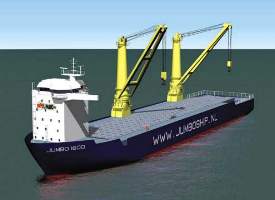NETHERLANDS: Two super-heavylift newbuilds ordered
April 2001 Vol. 222 No. 4 Feature Article THE NETHERLANDS: Two super-heavylift newbuilds ordered Dutch heavylift-shipping specialist, JUMBO, has ordered tw
THE NETHERLANDS:Two super-heavylift newbuilds orderedDutch heavylift-shipping specialist, JUMBO, has ordered two super-heavylift vessels from Damen Shipyards Group of the Netherlands. Scheduled for delivery in 2003, the new 11,000-dwt, J-1600 class will be the heaviest heavylift vessels in the world. The order reflects the company’s intent to further expand into the offshore and high-end petrochemical markets. Design of the new super-heavylift J-1600 class reflects increased demand for greater lift and outreach capabilities. The vessels’ equipment takes account of market needs. The newbuilds will have two state-of-the-art, rotating-mast cranes with a combined lift capacity of 1,600 t, and a maximum outreach of 35 m. For highly efficient general-cargo handling, the main hoists are supplemented with a range of other handling systems. The vessels’ shallow 6.5-m draft maintains small-port operational capability that is the basis of the company’s fleet.
Versatility was the primary concern when the company developed the new J-1600 class specification. The deckhouse and bridge, for example, is placed forward and only extends across half the deck width, which maximizes available deck space. This high level of operational flexibility is essential in the heavylift market, where industrial components such as reactor columns can exceed 150 m in length. With an overall length of 143 m, the newbuilds will have a completely flush main deck with a 26.5-m width. Deck width can be extended to 39.3 m using "fly-decks." For optimum stowage configuration, each tweendeck pontoon is variable in height. The standard underdeck height may be extended to 15 m from 12.5 m. The two main engines, rated at 4,320 kW, allow speeds of up to 17.5 knots. The company’s existing fleet capacity will double following delivery of the J-1600 class ships in 2003, and the H-800 Jumbo Vision and Fairlane in 2001 and 2002, respectively. Demand for greater lifting capacity is increasing. For example, in the offshore and petrochemical sectors, reactors and process modules are continually getting heavier and larger. These markets need ships that can lift great weights and be positioned where and when required at cost-effective rates. Following dollar and oil-price stabilization, oil
companies are now expanding their exploration and production activities, which will boost demand for
transportation services, particularly concerning the outfitting of FPSOs. In the chemicals industry, following
a period of consolidation, companies are again starting up new projects. |
- Applying ultra-deep LWD resistivity technology successfully in a SAGD operation (May 2019)
- Adoption of wireless intelligent completions advances (May 2019)
- Majors double down as takeaway crunch eases (April 2019)
- What’s new in well logging and formation evaluation (April 2019)
- Qualification of a 20,000-psi subsea BOP: A collaborative approach (February 2019)
- ConocoPhillips’ Greg Leveille sees rapid trajectory of technical advancement continuing (February 2019)



